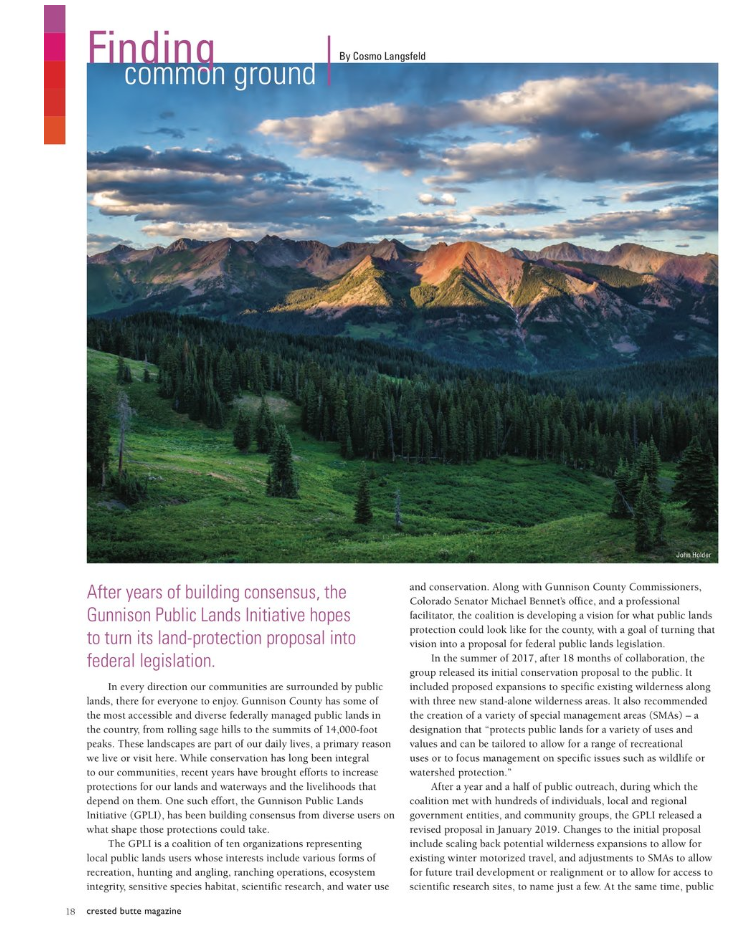Finding Common Ground
June 23, 2019
Crested Butte Magazine Summer 2019
Cosmo Langsfeld
In every direction our communities are surrounded by public lands, there for everyone to enjoy. Gunnison County has some of the most accessible and diverse federally managed public lands in the country, from rolling sage hills to the summits of 14,000-foot peaks. These landscapes are part of our daily lives, a primary reason we live or visit here. While conservation has long been integral to our communities, recent years have brought efforts to increase protections for our lands and waterways and the livelihoods that depend on them. One such effort, the Gunnison Public Lands Initiative (GPLI), has been building consensus from diverse users on what shape those protections could take.
The GPLI is a coalition of ten organizations representing local public lands users whose interests include various forms of recreation, hunting and angling, ranching operations, ecosystem integrity, sensitive species habitat, scientific research, and water use and conservation. Along with Gunnison County Commissioners, Colorado Senator Michael Bennet’s office, and a professional facilitator, the coalition is developing a vision for what public lands protection could look like for the county, with a goal of turning that vision into a proposal for federal public lands legislation.
In the summer of 2017, after 18 months of collaboration, the group released its initial conservation proposal to the public. It included proposed expansions to specific existing wilderness along with three new stand-alone wilderness areas. It also recommended the creation of a variety of special management areas (SMAs) – a designation that “protects public lands for a variety of uses and values and can be tailored to allow for a range of recreational uses or to focus management on specific issues such as wildlife or watershed protection.”
After a year and a half of public outreach, during which the coalition met with hundreds of individuals, local and regional government entities, and community groups, the GPLI released a revised proposal in January 2019. Changes to the initial proposal include scaling back potential wilderness expansions to allow for existing winter motorized travel, and adjustments to SMAs to allow for future trail development or realignment or to allow for access to scientific research sites, to name just a few. At the same time, public comment led to expanded boundaries and protections for other parcels in the 2019 version.
One example of proposed protection is the Deer Creek Protection Area and Wilderness Addition. This area, near the town of Crested Butte, is located in the upper East River Valley on the southwest flanks of White Mountain and WSC Peak. The coalition recommends an expansion of the existing Maroon-Bells Wilderness down to a section of the Deer Creek Trail. Below this elevation, the GPLI recommends the implementation of an SMA to allow mountain bikers to access the popular trail in the summer months and to accommodate current ranching operations and water use. These protections, over a large elevation gradient, would preserve critical habitat for migrating elk — and allow for the future preservation of diverse habitats and ecosystems as native flora and fauna adapt to the effects of climate change.
The original recommendations resulted from discussions between coalition members and were aimed at preserving the values identified by the various stakeholders. Changes to the 2017 recommendations resulted from public input. For instance, during the public comment period, the GPLI learned that snowmobilers recreate in the lower-angled slopes in the vicinity of Deer Creek. To balance the needs of different interest groups and to correct inaccuracies regarding winter use prescriptions, the coalition adjusted its recommendations to permit winter motorized use within the Deer Creek Protection Area.
With more than 450,000 acres of consensus-recommended public lands protections in the revised package, the coalition has begun discussing how to turn its recommendations into law, and it will be moving into the legislative process in the coming years.
For certain areas, the coalition is still engaged with local communities to determine how management designations could best serve those who live near and use that land. These sections are deemed Areas in Discussion, and no recommendations will be put forth without “thorough, proper analysis” and broad support from their respective communities.
To meet the needs of these communities, the coalition is very much thinking about the future. As the GPLI states on its website, the Colorado state demographer has projected a population growth in Gunnison County of about 50% over the next 30 years. As more people move to the area, and the local outdoor recreation industry continues to thrive, public lands around Gunnison County will see much higher demand. Much of the land the coalition is seeking to protect contains important wildlife habitat, including for the Gunnison sage grouse – classified as “threatened” under the Endangered Species Act – as well as vital winter habitat for elk and mule deer.
The values identified by the Gunnison Public Lands Initiative are elements that, once gone, could be irretrievable. With help from the community, the coalition sees an opportunity to preserve those resources for future generations while planning for the shifts in culture that will inevitably come with a growing population.
To find out more about the GPLI or to read the 2019 proposal, visit www.gunnisonpubliclands.org.



